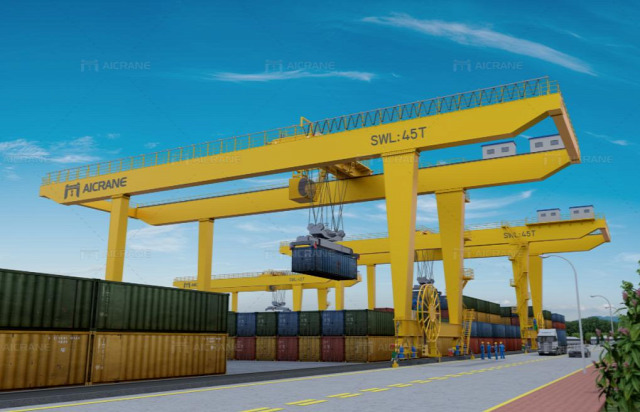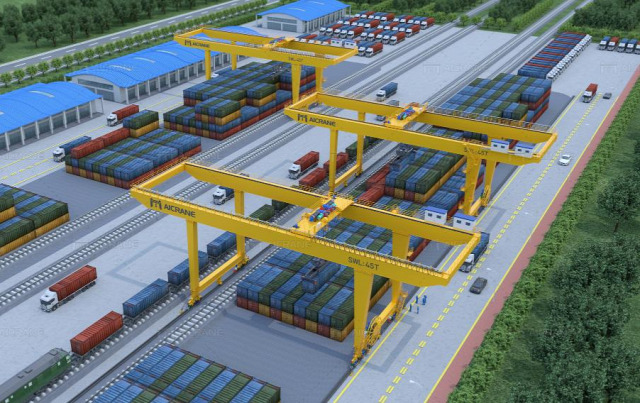Container gantry cranes are vital equipment for efficient cargo handling at ports and container yards. However, the heavy loads and complex operations involved make safety a paramount concern. Understanding safe operational practices can reduce accidents, protect workers, and improve overall operational efficiency. This article highlights essential guidelines and best practices for the safe operation of container gantry cranes.

1. Conduct Regular Training for Operators
Operators are responsible for safe crane operation, and they must be well-trained to manage the equipment and respond to potential hazards. Training should include:
- Technical Operation: Operators should understand how to control the crane, manage loading and unloading processes, and handle emergency stops.
- Safety Protocols: Emphasize adherence to established safety protocols, including recognizing and mitigating risks, understanding safety limits, and following standard operating procedures.
- Periodic Refresher Courses: Ongoing training ensures that operators stay up-to-date with the latest safety standards and technological advancements.
2. Pre-Operation Inspections
Before starting any shift, operators and maintenance staff should conduct a thorough pre-operation inspection. This includes:
- Checking Structural Integrity: Inspect beams, joints, and load-bearing components for signs of wear or damage.
- Electrical and Hydraulic System Check: Verify the crane's power sources and ensure hydraulic systems function without leaks or issues.
- Control System Inspection: Test the crane’s control system, including emergency stops and limit switches, to confirm they are functioning correctly.
Regular inspections can prevent malfunctions and address potential issues before they escalate, minimizing downtime and maintaining safety standards.

3. Load Handling Best Practices
The safe handling of loads is critical when operating a container gantry crane. Operators should follow these best practices:
- Know the Load Capacity: Always operate within the specified load capacity. Overloading the crane can cause mechanical stress, leading to potential equipment failure or tipping hazards.
- Maintain a Balanced Load: Ensure that containers are securely attached and balanced before lifting. Swinging or unbalanced loads can create instability and may harm both the equipment and personnel nearby.
- Use Anti-Sway Technology: Many modern Aicrane gantry cranes are equipped with anti-sway technology. This feature stabilizes the load, enabling smooth, precise movement and reducing the risk of accidents caused by swinging containers.
4. Monitor Environmental Conditions
External conditions like weather and visibility play a crucial role in safe crane operation. For instance:
- Wind Speeds: Strong winds can compromise crane stability and control, especially when handling high stacks of containers. If wind speeds exceed safe operating limits, cease operations until conditions improve.
- Fog and Low Visibility: Poor visibility makes it difficult to align containers correctly and avoid obstacles. Operators should be cautious and follow strict guidelines for operating in low-visibility conditions, potentially using additional visual aids or cameras if available.
- Rain and Ice: Wet or icy conditions make surfaces slippery, increasing the risk of slippage or collision. Ensure the crane and surrounding surfaces are clear and dry, and take extra care with traction during adverse weather.
5. Maintain Clear Communication
Effective communication among the crane operator, ground staff, and other personnel is essential to prevent accidents. Best practices include:
- Two-Way Radios: Use two-way radios or other reliable communication systems to facilitate clear, continuous communication.
- Hand Signals and Visual Aids: In noisy or low-visibility areas, hand signals and visual aids provide an additional layer of communication.
- Coordination Protocols: Establish protocols for movement and load transfer, ensuring that all parties know where to stand and how to stay safe during operations.
6. Implement Lockout/Tagout Procedures
Lockout/tagout (LOTO) procedures help prevent unintended crane movement during maintenance or repair activities. These steps ensure that the crane is safely de-energized, and a visible lock or tag alerts personnel that work is being performed. LOTO procedures involve:
- Isolation of Energy Sources: Deactivate and isolate all energy sources (electricity, hydraulics) that power the crane.
- Tagging: Clearly tag the controls to indicate that maintenance is in progress, reducing the risk of accidental activation.
- Verification: Confirm that all energy sources are disconnected before beginning maintenance, preventing the accidental reactivation of the crane.
7. Regular Maintenance and Repair
Routine maintenance is key to prolonging the crane’s lifespan and ensuring safe operation. Maintenance schedules should include:
- Lubrication of Moving Parts: Keep parts well-lubricated to prevent wear and friction, which could compromise crane performance.
- Inspection of Cables and Brakes: Cables, brakes, and other high-stress components should be checked regularly to identify signs of wear and replace them before they fail.
- Timely Repairs: Address any issues identified during inspections without delay, and ensure that all repairs are carried out by qualified professionals.
8. Emergency Response Preparedness
Being prepared for emergencies can significantly reduce the impact of accidents. Safety plans should cover:
- Emergency Stop Procedures: Operators should know how to stop the crane immediately in case of a malfunction or hazard.
- Evacuation Routes: Workers should have clear evacuation routes in case of a dangerous situation or crane failure.
- First Aid Training: Personnel should have access to first aid equipment and be trained to provide basic assistance in case of injury.
Regular emergency drills can help reinforce these procedures, ensuring everyone knows their role in an emergency scenario.
9. Invest in Advanced Safety Technologies
Modern container gantry cranes often feature advanced safety technologies that enhance operational safety, such as:
- Collision Avoidance Systems: These systems use sensors and alarms to detect obstacles and prevent collisions during crane movement.
- Load Monitoring Systems: Real-time monitoring of load weight and position can alert operators if they approach the crane’s load limits.
- Automated Crane Controls: Automation features, such as automated hoisting and trolley movements, reduce the likelihood of human error, leading to safer and more efficient operations.
10. Compliance with Safety Standards and Regulations
Operators must comply with national and international safety regulations, such as those set by OSHA, ISO, and local regulatory bodies. These standards offer guidelines on safe operation, maintenance requirements, and employee training. Adherence to these standards ensures that operations are consistent with industry best practices, reducing risks and legal liabilities.
Conclusion
Safe operation of container gantry cranes is essential for protecting workers, equipment, and cargo. By following these guidelines—ensuring regular training, conducting pre-operation inspections, handling loads carefully, monitoring environmental conditions, maintaining clear communication, implementing lockout/tagout procedures, prioritizing regular maintenance, preparing for emergencies, leveraging safety technologies, and complying with safety standards—operators can create a safer work environment and optimize crane performance. Practicing these safety measures not only safeguards personnel but also enhances the overall productivity and efficiency of container handling operations.

